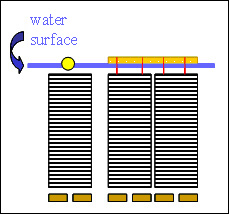The ZebraFilter®-method makes use of the enormous filtration capacity of the zebra mussel in order to remove algae, bacteria and other suspended solids from lake waters. The lake becomes clearer, surplus nutrients are removed and the bacterial content decreases, which is especially important in bathing waters.
From time to time mussels excrete the filtered particles in form of compact clots, so called pseudofaeces, comparable to tiny dust bags. The ZebraFilter method concentrates mussels in those places where the cleaning power is needed. A ZebraFilter-unit consists of a special carrier mat for zebra mussels, a scaffold and a collective- and suction device for the remaining clots. All remains are bio-degradable.
Zebra mussels (Dreissena sp.) have been endemic within Europe already before the ice age and there is massive incidence in Berlin and the federal state of Brandenburg.
No new mussels are placed into waters, but only empty carrier mats: Mussels of the native population proliferate via free floating larvae, they settle in the “new flats” of the ZebraFilter-unit and grow up to adult mussels. Therefore, the ZebraFilter unit is like an artificial reef for the hard-working filter-organisms in order to make use of their enormous ecological purification capacity for clean natural waters.
The procedure was developed at the Technical University of Dresden (Germany) during a project of the German Ministry of Research. Promoted by the environmental office of Charlottenburg (Berlin, Germany) it is now applied in a natural lake in Berlin for the first time. You will find more information concerning the scientific background at www.ZebraFilter.de.
Figure:
Schematic drawing of a ZebraFilter unit: special carrier mats for zebra mussels are placed vertically in the water body. They are held by a floating body (buoy or bamboo) at the water surface and by a catch basin for the remaining filtrate at the bottom. Filtering mussels are concentrated in those places where their cleaning capacity is wanted.
|
 |